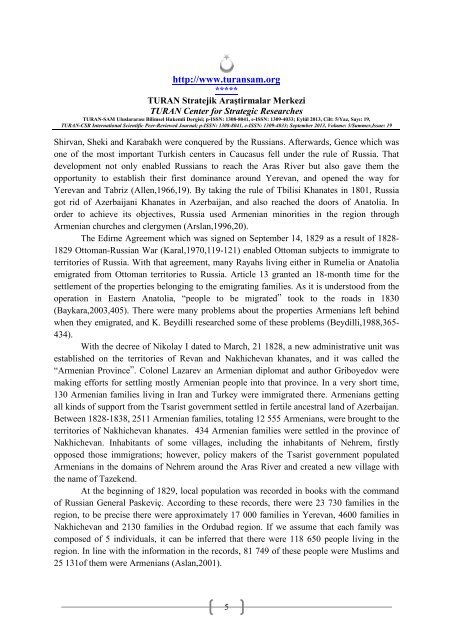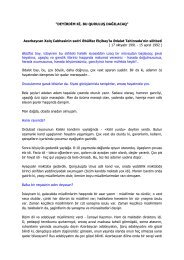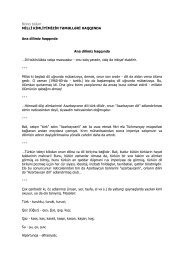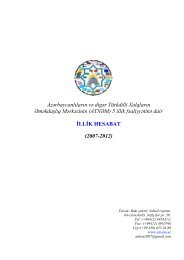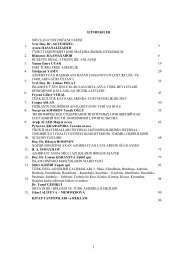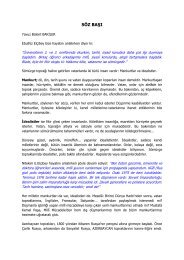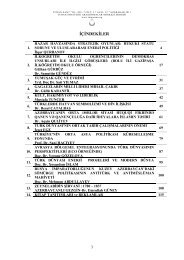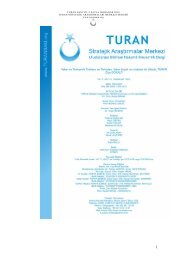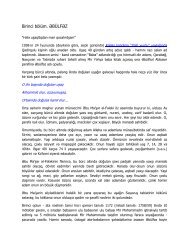19. Sayı; TURAN-SAM YAZ Sayısı, 2013
19. Sayı; TURAN-SAM YAZ Sayısı, 2013
19. Sayı; TURAN-SAM YAZ Sayısı, 2013
- No tags were found...
You also want an ePaper? Increase the reach of your titles
YUMPU automatically turns print PDFs into web optimized ePapers that Google loves.
http://www.turansam.org*****<strong>TURAN</strong> Stratejik Araştirmalar Merkezi<strong>TURAN</strong> Center for Strategic Researches<strong>TURAN</strong>-<strong>SAM</strong> Uluslararası Bilimsel Hakemli Dergisi; p-ISSN: 1308-8041, e-ISSN: 1309-4033; Eylül <strong>2013</strong>, Cilt: 5/Yaz, Sayı: 19,<strong>TURAN</strong>-CSR International Scientific Peer-Reviewed Journal; p-ISSN: 1308-8041, e-ISSN: 1309-4033; September <strong>2013</strong>, Volume: 5/Summer,Issue: 19Shirvan, Sheki and Karabakh were conquered by the Russians. Afterwards, Gence which wasone of the most important Turkish centers in Caucasus fell under the rule of Russia. Thatdevelopment not only enabled Russians to reach the Aras River but also gave them theopportunity to establish their first dominance around Yerevan, and opened the way forYerevan and Tabriz (Allen,1966,19). By taking the rule of Tbilisi Khanates in 1801, Russiagot rid of Azerbaijani Khanates in Azerbaijan, and also reached the doors of Anatolia. Inorder to achieve its objectives, Russia used Armenian minorities in the region throughArmenian churches and clergymen (Arslan,1996,20).The Edirne Agreement which was signed on September 14, 1829 as a result of 1828-1829 Ottoman-Russian War (Karal,1970,119-121) enabled Ottoman subjects to immigrate toterritories of Russia. With that agreement, many Rayahs living either in Rumelia or Anatoliaemigrated from Ottoman territories to Russia. Article 13 granted an 18-month time for thesettlement of the properties belonging to the emigrating families. As it is understood from theoperation in Eastern Anatolia, “people to be migrated” took to the roads in 1830(Baykara,2003,405). There were many problems about the properties Armenians left behindwhen they emigrated, and K. Beydilli researched some of these problems (Beydilli,1988,365-434).With the decree of Nikolay I dated to March, 21 1828, a new administrative unit wasestablished on the territories of Revan and Nakhichevan khanates, and it was called the“Armenian Province”. Colonel Lazarev an Armenian diplomat and author Griboyedov weremaking efforts for settling mostly Armenian people into that province. In a very short time,130 Armenian families living in Iran and Turkey were immigrated there. Armenians gettingall kinds of support from the Tsarist government settled in fertile ancestral land of Azerbaijan.Between 1828-1838, 2511 Armenian families, totaling 12 555 Armenians, were brought to theterritories of Nakhichevan khanates. 434 Armenian families were settled in the province ofNakhichevan. Inhabitants of some villages, including the inhabitants of Nehrem, firstlyopposed those immigrations; however, policy makers of the Tsarist government populatedArmenians in the domains of Nehrem around the Aras River and created a new village withthe name of Tazekend.At the beginning of 1829, local population was recorded in books with the commandof Russian General Paskeviç. According to these records, there were 23 730 families in theregion, to be precise there were approximately 17 000 families in Yerevan, 4600 families inNakhichevan and 2130 families in the Ordubad region. If we assume that each family wascomposed of 5 individuals, it can be inferred that there were 118 650 people living in theregion. In line with the information in the records, 81 749 of these people were Muslims and25 131of them were Armenians (Aslan,2001).5


